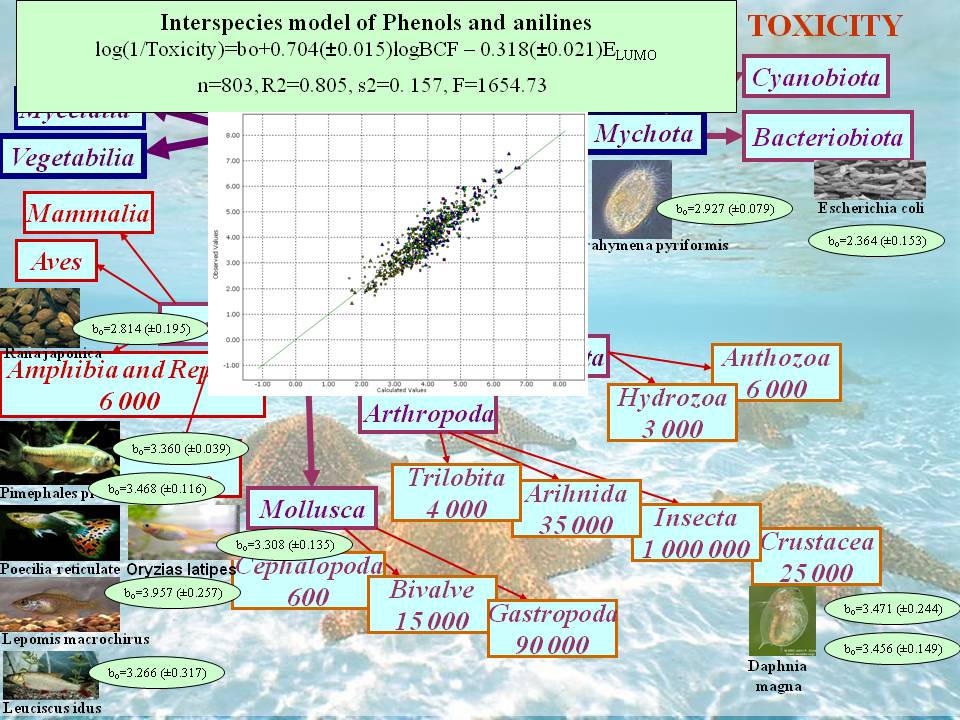Daphnia magna LC50 48h
Endpoint
The acute aquatic toxicity model predicts the concentration of chemicals that kill 50% (LC50) of the test population Daphnia magna within a designated period.
Data
The training set consists of LC50 values for 334 chemicals [1-7]:
- Test duration - 48 hours,
- Test species - Daphnia magna (water flea).
The tested chemicals belong to the following categories:
- Narcotic toxicants - 124 chemicals,
- Esters - 6 chemicals,
- Reactive unspecified chemicals - 183 chemicals.
Model
The organism response to the presence of toxicant in the environment is considered as a consequence of the combined influence of two different processes: uptake of the chemical into the biophase and interaction with the site of action [8]. In the present model, the uptake is modeled by maximum potential of the toxicant to bioconcentrate in the fish, while the interaction of chemicals is explained by descriptors assessing the electrophilic character of the molecule [9]. Such descriptors could include the energy of the lowest unoccupied molecular orbital, electronegativity, average or maximum superdelocalizability, maximum charge at non-hydrogen atom, etc. The following models were developed based on regression analysis of the data:
Narcotic toxicants
log 1/EC50 = 1.53(±0.12)+1.22(±0.05) logBCFmax -0.09(±0.04)ELUMO
Esters
log 1/EC50 = 2.24(±0.39)+0.69(±0.22) logBCFmax -0.33(±0.24)ELUMO
where BCFMax is the maximum bioconcentration factor [10], and ELUMO is the energy of the lowest unoccupied molecular orbital. For the reactive unspecified chemicals, only the minimum toxicity is determined based on the model for narcotic chemicals (i.e., log 1/EC50 ≥ log 1/EC50 of narcotics).
Domain
The stepwise approach [11] was used to define the applicability domain of the model. It consists of the following sub-domain levels:
- General parametric requirements - includes ranges of variation of log KOW and MW,
- Structural domain - based on atom-centered fragments (ACFs).
A chemical is considered In Domain if its log KOW and MW are within the specified ranges and its ACFs are presented in the training chemicals. The information implemented in the applicability domain is extracted from the correctly predicted training chemicals used to build the model and in this respect the applicability domain determines practically the interpolation space of the model.
Statistics
The precision of the regression model is characterized by the following estimates - the 95% confidence intervals of model parameters, coefficient of determination (R2), mean squared error (estimate of error variance, s2), F value:
Narcotic toxicants
- Coefficient of determination R2 = 0.89,
- Mean squared error (estimate of error variance) s2 = 0.27,
- F value = 463.98,
- Number of chemicals, n = 124.
Esters
- Coefficient of determination R2 = 0.90,
- Mean squared error (estimate of error variance) s2 = 0.15,
- F value = 13.58,
- Number of chemicals, n = 6.
References
1. Zhao YH, Ji GD, Cronin MTD, Dearden JC. 1998. QSAR study of
the toxicity of benzoic acids to Vibrio fischeri, Daphnia magna and
carp. The Science of the Total Environment 216: 205-215.
2. Schuurmann G. 1998. Ecotoxic Modes of Action of Chemical
Substances. 22.
3. Aromatic compounds aquatic toxicity QSAR using molecular
quantum similarity measures, D. Robert, R. Carbo-Dorca, SAR QSAR
Environ. Res. 10 (1999) 401-422.
4. Zhao YH, Cronin MTD, Dearden JC. 1998. Quantitative
Structure-Activity Relationships of Chemicals Acting by Non-polar
Narcosis- Theoretical Considerations. Quant. Struct.-Act. Relat.
17: 131-138.
5. Ramos EU. 1998. Aquatic Toxicity of Polar Narcotic Pollutants.
Mechanism, Modeling and Environmental Effect Assessment. Ph.D
Thesis.
6. Estimating environmentally important properties of chemicals
from the chemical structure - Erik Furusjo, Magnus Andersson,
Magnus Rahmberg, Anders Svenson - Report B1517.
7. Ohe PC, Kuhne R, Ebert R-U, Altenburger R, Liess M, Schuurmann
G. 2005.Structural Alerts-A New Classification Model to
Discriminate Excess Toxicity from Narcotic Effect Levels of Organic
Compounds in the Acute Daphnid Assay. Chem. Resear. Toxicol. 18(3):
536-555.
8. J.W. McFarland, J. Med. Chem. 13 (1970) 1092-1196.
9. S.D. Dimitrov, O.G. Mekenyan, G.D. Sinks, T.W. Schultz, Journal
of Molecular Structure (Theochem, 622 (2003) 63-70.
10. S. Dimitrov, N. Dimitrova, D. Georgieva, K. Vasilev, T.
Hatfield, J. Straka, O. Mekenyan, SAR and QSAR in Environmental
Research, 23 (2012) 17-36.
11. S. Dimitrov, G. Dimitrova, T. Pavlov, N. Dimitrova, G.
Patlevisz, J. Niemela and O. Mekenyan, J. Chem. Inf. Model. 45
(2005) 839-849.



